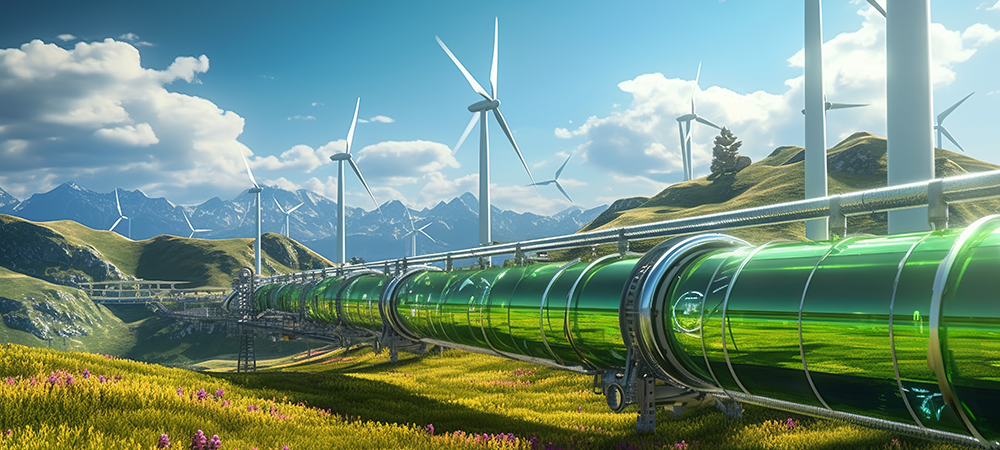Disrupting the fossil fuel economy to make way for the green hydrogen economy needs to be supported by digital twin software and IoT in manufacturing and utilities says Evgeny Fedotov at AVEVA.
Green hydrogen is one of the world’s great keys to meeting growing energy needs. Strong hydrogen demand growth and the adoption of clean technologies for its production are set to drive global decarbonisation efforts, particularly in more challenging sectors, such as heavy industry and transport.
The Middle East is set to play a major role in the development of the global green hydrogen industry and supply chain. Much of the region holds significant advantages in the production of green energies, due to abundant, low-cost solar energy.
The Gulf is already home to some of the largest and most advanced hydrogen projects. For instance, the NEOM Green Hydrogen Project in Saudi Arabia will produce 1.2 million t per y of green ammonia for export. Another example is Oman’s green hydrogen auction process, which awarded five large-scale projects in its first round, totalling $30 billion investments and 750 ktpa green hydrogen production.
Egypt recently signed an MoU to build a green hydrogen factory in the Suez Canal Economic Zone, which will produce 20,000 tonnes of green hydrogen a year, with investments worth $8 billion. Such investments will not only generate regional income streams and help secure energy supply, but also promote economic diversification.
According to a MEED intelligence report, North African nation Egypt has invested in projects worth $63.8 billion, while Oman follows with projects worth $48.9 billion. Saudi Arabia and the UAE have invested in projects worth $10.5 billion and $10.28 billion, respectively.
Egypt, in particular, with its generous access to wind and solar, and billion-dollar port upgrade plan, has set its sights on becoming a key global green hydrogen player. From a regional standpoint, the race is on to discover who will take pole position in the industry’s next phase of development.
In future, hydrogen-powered vehicles could improve air quality and promote energy security. Hydrogen can also store energy from renewable sources, making it a crucial component of the transition to a low-carbon economy. Ultimately, a globally sustainable and reliable non-fossil fuel energy system could be realised through hydrogen, using renewable energy sources instead of fossil fuels like natural gas.
Yet, given the diverse networks within the global energy ecosystem, ushering in the green hydrogen era will require a considered approach. How we produce, transport, and consume green hydrogen needs to be broader and encompass more stakeholders. Such efforts call for rigorous regional and global collaboration.
Green hydrogen requires costly transportation to supply large export markets in Europe and East Asia from Middle Eastern source markets. According to a report from management consultants Strategy&, the green hydrogen market will be won in the supply chain.
The best way for GCC producers to supply large export markets is to use renewable energy to convert green hydrogen to green ammonia. GCC producers would then crack the ammonia at the export destination to extract the hydrogen for end use.
The global green hydrogen economy is challenging because it is as yet uncharted. To succeed, its burgeoning ecosystem will need to be able to adjust to unique requirements and many unsettled elements. Optimising production will rely on visibility across the value chain. Ultimately, it will be down to data connectivity to optimally power global green hydrogen.
Improving how green hydrogen is processed and ultimately used by the consumer will require extrapolating insights from existing plant projects, learning more about the yields from our most viable technologies, and deciding the role that utilities companies will play in tomorrow’s green hydrogen ecosystem.
Today’s software solutions can help save costs and optimise hydrogen plant efficiency by collecting and measuring operational data of plant infrastructure through embedded IoT devices. These data inputs are used to recreate digital-twin models of plants to optimise operations and yield improved plant performance. Across the world, swathes of individual industrial plants are already incorporating digital twins into their daily operations.
An example can be seen in German engineering giant Thyssenkrupp, which has been commissioned to construct an 88-megawatt water electrolysis plant for Hydro-Québec, one of the largest hydropower suppliers in Canada. The plant will produce 11,100 metric tons of green hydrogen annually. Both the hydrogen and the oxygen, a by-product of the electrolysis process, will be used to produce biofuels for the transportation sector.
ThyssenKrupp’s engineering team is using AVEVA Engineering software in green hydrogen plant design, together with AVEVA PI System data to optimise operational design. By using data visualisation tools ThyssenKrupp is able to increase operational efficiency, improve collaboration and drive sustainability throughout its design process and project execution.
On a regional and worldwide scale, connecting up the hydrogen ecosystem creates a path to quicker plant set up, cost-effective operations, and production efficiency.
Engineering advancements have to be matched with a unified common data infrastructure to create positive outcomes for everyone. Through optimised data flows and accessible data across the value-chain, the Middle East’s green hydrogen ecosystem will be given the best opportunity to flourish.

Market place dynamics
Challenges
- Given diverse networks within the global energy ecosystem, ushering in the green hydrogen era will require a considered approach.
- How we produce, transport, and consume green hydrogen needs to be broader and encompass more stakeholders.
- Green hydrogen requires costly transportation to supply large export markets in Europe and East Asia.
- The best way for Middle East producers to supply large markets is to use renewable energy to convert green hydrogen to green ammonia.
Solutions
- According to Strategy&, the green hydrogen market will be won in the supply chain.
- Optimising production will rely on visibility across the value chain.
- It will be down to data connectivity to optimally power global green hydrogen.
- Improving how green hydrogen is processed will require insights from plant projects, learning about yields, the role utilities will play.
- Software can help save costs and optimise efficiency by collecting operational data through embedded IoT devices.
- Data inputs are used to recreate digital-twin models of plants to optimise operations and improved plant performance.
Benefits
- The Gulf is already home to some of the largest and most advanced hydrogen projects.
- Hydrogen-powered vehicles could improve air quality and promote energy security.
- Hydrogen can also store energy from renewable sources, making it a crucial component of the transition to a low-carbon economy.
- Globally sustainable and reliable non-fossil fuel energy system could be realised through hydrogen.
Click below to share this article


